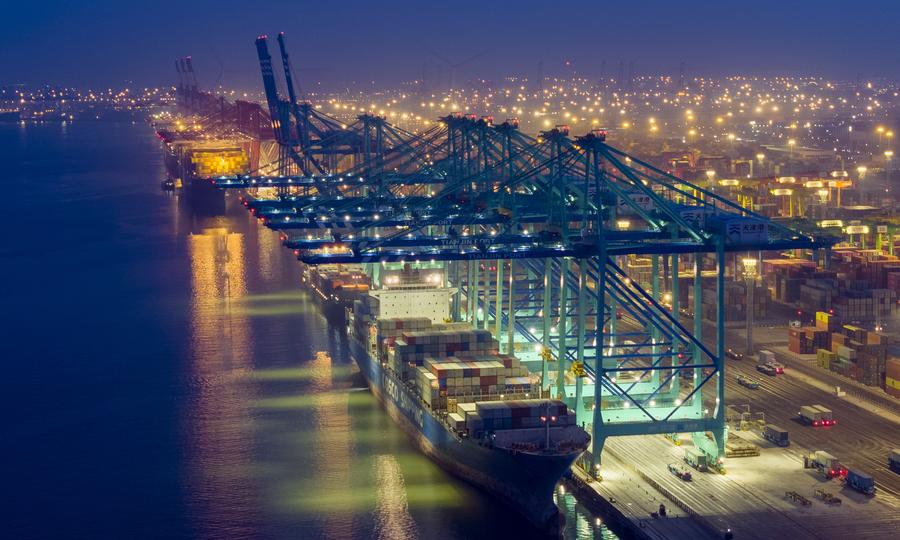Top-level design charts course for Jing-Jin-Ji coordinated development


BEIJING -- In northern China, a megacity cluster -- known as "Jing-Jin-Ji" -- spanning an area of 216,000 square km and with a population of over 100 million, is emerging as one of the country's most dynamic, open, and innovative regions.
Since February 2014, the coordinated development of the Jing-Jin-Ji region, or the Beijing-Tianjin-Hebei region, has been a key national strategy. President Xi Jinping has planned and boosted this historic regional initiative.
Over the past decade, Xi, also general secretary of the Communist Party of China Central Committee and chairman of the Central Military Commission, has made a series of instructions regarding the coordinated development of this region.
He also chaired multiple meetings to chart the course of the strategy and made several fact-finding trips to gain inspiration and assess progress.
OVERARCHING DESIGN
For an extended period, the region had grappled with prominent issues including "urban ills" and development gaps.
"The coordinated development of the Jing-Jin-Ji region holds significant importance; our understanding of this issue must be elevated to the level of national strategy," Xi said at a meeting on bolstering collaboration among Beijing, Tianjin, and Hebei in February 2014. He urged the region to explore a sustainable development path that leverages complementary strengths and yields mutual benefits.
In 2015, a plan for the Jing-Jin-Ji coordinated development was adopted at a Party leadership meeting chaired by Xi, propelling the strategy into a new stage of comprehensive implementation and accelerated advancement.
The following year, at another Party leadership meeting, Xi introduced a new strategic vision -- constructing the "two wings" of the country's capital, namely, the Beijing Municipal Administrative Center and the Xiong'an New Area in Hebei. This marked a significant advancement in promoting coordinated development in the region.
In 2019, at the second meeting focused on Jing-Jin-Ji coordinated development held after his inspection of Xiong'an, Tianjin and Beijing, Xi emphasized, "It is imperative to maintain historical patience and strategic determination in materializing this historic project."
In 2023, Xi visited Xiong'an again. There, a dynamic scene unfolded in the "city of the future," with countless tower cranes busy at work on city construction.
Xi reminisced about his first visit to Xiong'an in early 2017, standing atop the expansive, dusty terrain as he revealed the blueprint for the area. "In just six years, the Xiong'an New Area has transitioned from mere concept to palpable reality," Xi said. "A highly modernized city rising from the ground is nothing short of miraculous."
After the inspection, Xi presided over the third themed meeting on Jing-Jin-Ji coordinated development, reiterating the importance of enhancing collaboration within the region and calling for efforts to build the region into "a pilot and demonstration zone in pursuing Chinese modernization."
KEY TASK
Back in February 2014, on the first leg of his inspection tour of the capital, Xi visited the Beijing Planning Exhibition Hall, and made it clear that the functions of the capital should be adjusted and anything nonessential should be trimmed.
Relieving Beijing of functions nonessential to its role as the capital has since been established in the region's coordinated development strategy.
So far, efforts in this regard have yielded preliminary results, including the moving of municipal government organs of Beijing, along with 61 state-owned enterprises under its supervision to the administrative center.
In the Xiong'an New Area, state-owned enterprises directly under the central government set up four headquarters and more than 200 subsidiaries or branches, and four universities including Beijing Jiaotong University have started constructing their new campuses in Xiong'an.
COORDINATED DEVELOPMENT
On Feb. 1, 2024, Xi traveled to Tianjin on a "Fuxing" bullet train to visit and greet grassroots officials and the public ahead of the Spring Festival.
The coordinated development of Beijing, Tianjin and Hebei remained an important subject at a meeting convened the following day for the local Party committee and government to report their work.
On this occasion, Xi asked about the railway service connecting Beijing and Tianjin. Learning that there were around 280 passenger trains that ply the route between Beijing and Tianjin every day, Xi said a Jing-Jin-Ji on rails is taking shape.
Progress has also been made in overall transportation, with traffic circles of 1 or 1.5 hours having basically been formed to link world-class city clusters in the region.
On industrial development, a model of Beijing-based research and development plus Tianjin-and-Hebei-based manufacturing is increasingly taking shape. Enterprises in Beijing's Zhongguancun area, known as "China's Silicon Valley," have established more than 10,000 branches in Tianjin and Hebei.
The combined GDP of Beijing, Tianjin and Hebei reached 10.4 trillion yuan (about $1.46 trillion) in 2023, an increase of 1.9 times from the figure in 2013.
- China recording rapid increase in flu cases
- New gas pipeline to benefit southern Xinjiang
- China holds first national civil service exam since raising eligibility age cap
- Chongqing launches scheduled freight train service to Budapest
- HKSAR govt pledges free housing for Tai Po fire victims until homes rebuilt
- Xi's article on CPC self-reform to be published




































